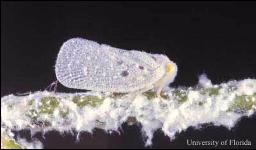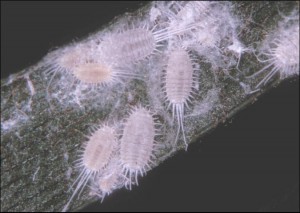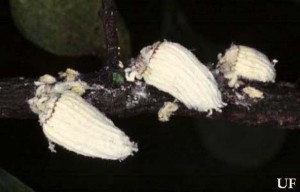Homeowner accounts of white fluffy woolly masses on woody ornamentals have been on the rise. They can appear on the ends of a wide variety of woody ornamental branches in the landscape. A closer inspection of these white woolly masses can provide the curious observer with a startling surprise. “It’s Alive!” It moves and seems to jump at you, most likely jumping away from you. Once you have recovered from the mildly frightful encounter, you ask yourself, “What was that?”

(Say). Credits: Photograph by: Lyle J. Buss, University of Florida
They are planthoppers (Metcalfa pruinosa), an insect in the order Hemiptera. The common name for this woolly looking planthopper is the citrus flatid planthopper (CFP). As the name implies, they occur on citrus but can also be found on many woody ornamentals and fruit trees. The adult planthopper wing arrangement is tent-like, meaning that the forewings are held over the insect abdomen in a tent configuration.

pruinosa (Say). Credits: Photograph by: Lyle J. Buss,
University of Florida
The nymph, young immature insect, produces the white woolly material that is characteristic of CFP. At first sight, they can be mistaken for mealy bugs, which may look similar since they are covered with cottony white filaments. They can also be mistaken for cottony cushion scale.

of Florida

Credits: James Castner, University of Florida
In both of these cases of mistaken identities, the insect will not jump or hop around. No chemical control is necessary although sooty mold can occur on heavily populated plants. In that case, a soapy water treatment can be applied.
Follow these links to more information on the citrus flatid planthopper, mealy bugs, and cottony-cushion scale.
 0
0

Comments:
August 12, 2016
Great article! For the record, Dr. Bill Anderson conducted the research in Tifton. I was a collaborator, but it was Bill and his crew that put in the sweat equity.
March 19, 2016
Do you have a similar for dog fennels? Thank you in advance.
July 30, 2015
Thanks for these good suggestions, Alex.
June 20, 2014
Alex, I really appreciate your professional guidance. To the average person something like this causes panic just based on their look. A white, woolly mass is a great description for them! And as usual, you didn't make me wait for the help I needed! Thanks!
March 26, 2014
The pictures located at http://nwdistrict.ifas.ufl.edu/hort/2014/03/25/titi-in-bloom-this-spring/ are hyperlinked, but when I click on them I receive the following error: 404 - File or directory not found. The resource you are looking for might have been removed, had its name changed, or is temporarily unavailable. Could you please correct this oversight? Thanks. Dixie I.
December 9, 2013
Snails feed on plants but are not harmful to the garden unless present in large quantities. It is probably looking for a place to over winter. Bring a sample to your nearest extension office for ID.
December 8, 2013
Good morning. We found a small snail in the driveway here where we live in N.W. Florida. What do these snails eat? Are they harmful to plants?
Comments are closed.